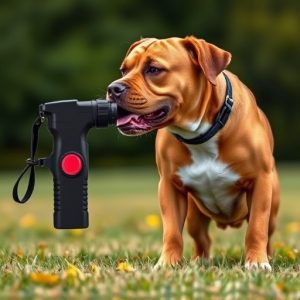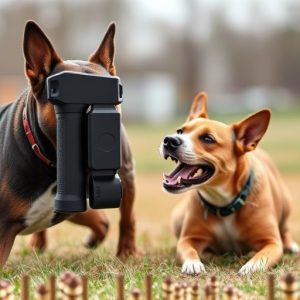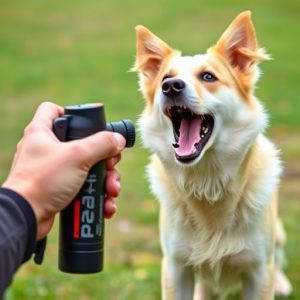Dog Spray Decoded: Effective Self-Defense Strategies Against Capsaicin
Dog spray, using capsaicin from chili peppers, is a powerful self-defense tool against aggressive do…….
Dog spray, using capsaicin from chili peppers, is a powerful self-defense tool against aggressive dogs. When comparing products, capsaicin content varies: 0.5% for training, and 2%+ for maximum deterrence against large dogs. Higher levels offer longer protection but should be avoided by sensitive individuals; lower concentrations are safer. Focus on capsaicin and solvent type when choosing a spray; water-based washes away faster, while oil-based lasts longer. Advanced formulations may include visibility additives. During an encounter, stay calm, assess the situation, and move away at an angle to protect yourself. Dog spray temporarily disables without causing permanent harm.
Staying safe during encounters with aggressive dogs is paramount. Dog spray, a popular self-defense tool, uses capsaicin—the same compound responsible for chili pepper’s heat—to deter attackers. Understanding the ingredients and effects of dog spray is crucial. This article breaks down the capsaicin content in various formulations, offering insights into their effectiveness. We explore practical self-defense strategies to help you navigate potentially dangerous situations, ensuring your safety through informed choices and tactical awareness.
- Understanding Dog Spray: Ingredients and Effects
- Capsaicin: The Active Component in Dog Spray
- Comparing Different Dog Spray Formulations
- Effective Self-Defense Strategies Against Dog Spray
Understanding Dog Spray: Ingredients and Effects
Dog spray, also known as pepper spray for dogs, is a powerful tool designed to deter aggressive canine behavior. Understanding its composition and effects is crucial for effective self-defense. The primary active ingredient in most dog sprays is capsaicin, derived from chili peppers. This compound stimulates nerve endings, causing a burning sensation and temporary blindness, which helps to disable the dog long enough for you to escape or defend yourself.
When comparing different dog spray products, one key metric to look at is the capsaicin content. This can vary widely between brands, with some offering lower concentrations (around 0.5%) suitable for training purposes, while others boast higher levels (up to 2% or more) designed for maximum deterrence. A higher capsaicin content generally translates to a longer lasting and more intense effect, making it ideal for real-world self-defense scenarios against large or aggressive dogs.
Capsaicin: The Active Component in Dog Spray
Capsaicin, the active component in dog spray, is a natural compound found in chili peppers. It’s what gives hot sauces their heat and irritates the eyes, nose, and throat when it comes into contact with them. Dog spray typically contains capsaicin at concentrations ranging from 2% to 10%, which can be enough to deter even the most aggressive dogs.
When comparing different dog sprays, understanding the capsaicin content is crucial. Higher concentrations of capsaicin offer longer-lasting protection and greater effectiveness. However, it’s essential to consider that some people may have sensitivities or allergies to capsaicin, so using dog spray with lower concentrations could be a safer option for them.
Comparing Different Dog Spray Formulations
When comparing different dog spray formulations, one key factor is the capsaicin content. Capsaicin, the active ingredient in chili peppers, is commonly used in dog sprays and its concentration can vary widely between products. Higher capsaicin content generally means a more potent spray, effective at deterring aggressive dogs from attacking. However, it’s crucial to consider that different formulations may have varying levels of irritancy for humans and other animals, making safety a top priority when choosing a self-defense option.
Additionally, the type of solvent used in the spray can impact its effectiveness and user experience. Water-based sprays might be easier on the skin but could potentially wash away faster, while oil-based formulas may linger longer but could be more irritating. Some advanced formulations include additives for enhanced visibility, ensuring that not only is the dog deterred, but users can also track the animal’s movements if needed. A thorough comparison of these aspects will help individuals select the best dog spray for their self-defense needs.
Effective Self-Defense Strategies Against Dog Spray
Staying safe during an encounter with a dog that sprays is paramount. Knowing effective self-defense strategies, especially against the capsaicin content in dog spray, can make all the difference. The first step is to maintain your composure and avoid triggering aggressive behaviors from the dog by remaining calm and assessing the situation.
If a dog approaches you and prepares to spray, quickly move away at an angle while keeping your body between the dog and any potential targets. Use non-violent physical barriers like a bag or jacket to shield yourself. Remember, dog spray is designed to temporarily disable, not cause permanent harm. Understanding the capsaicin content—the active ingredient in most dog sprays—can help you plan your next moves effectively. Some sprays contain higher concentrations of capsaicin, which can provide more time to escape but also intensify discomfort.
Dog spray, primarily composed of capsaicin, serves as a powerful self-defense tool against aggressive canines. By understanding the active ingredients and their effects, individuals can make informed choices among various formulations. A comprehensive comparison highlights the importance of capsaicin content in ensuring effectiveness. When armed with this knowledge, one can employ strategic self-defense strategies, combining physical tactics and quick thinking to navigate potential dog encounters safely.


